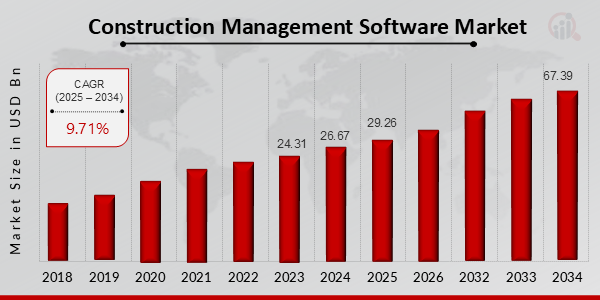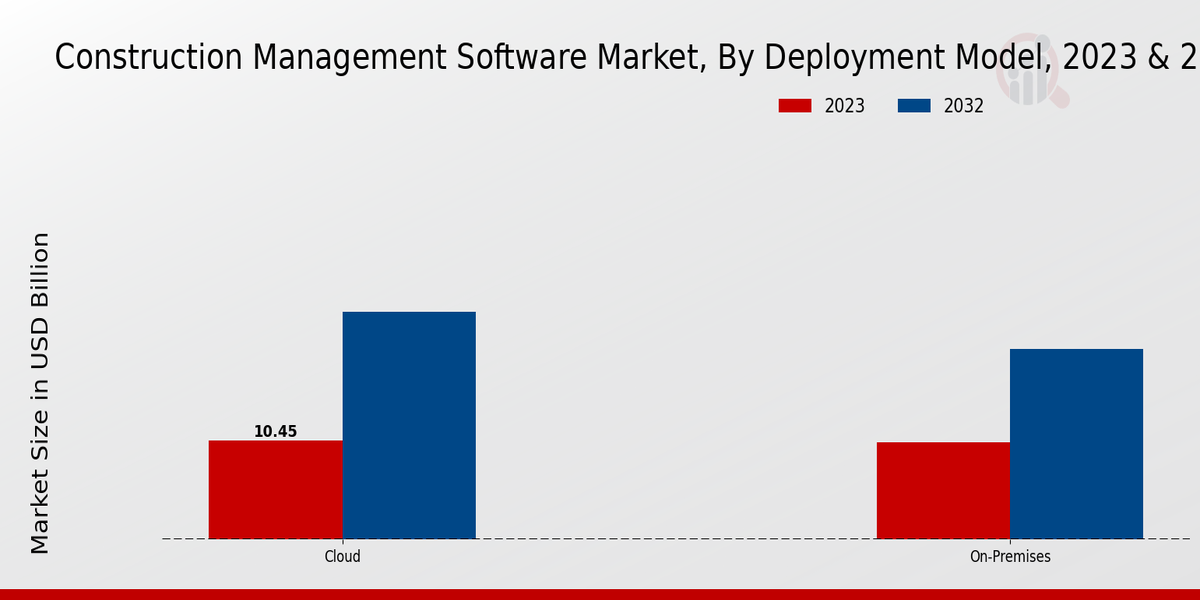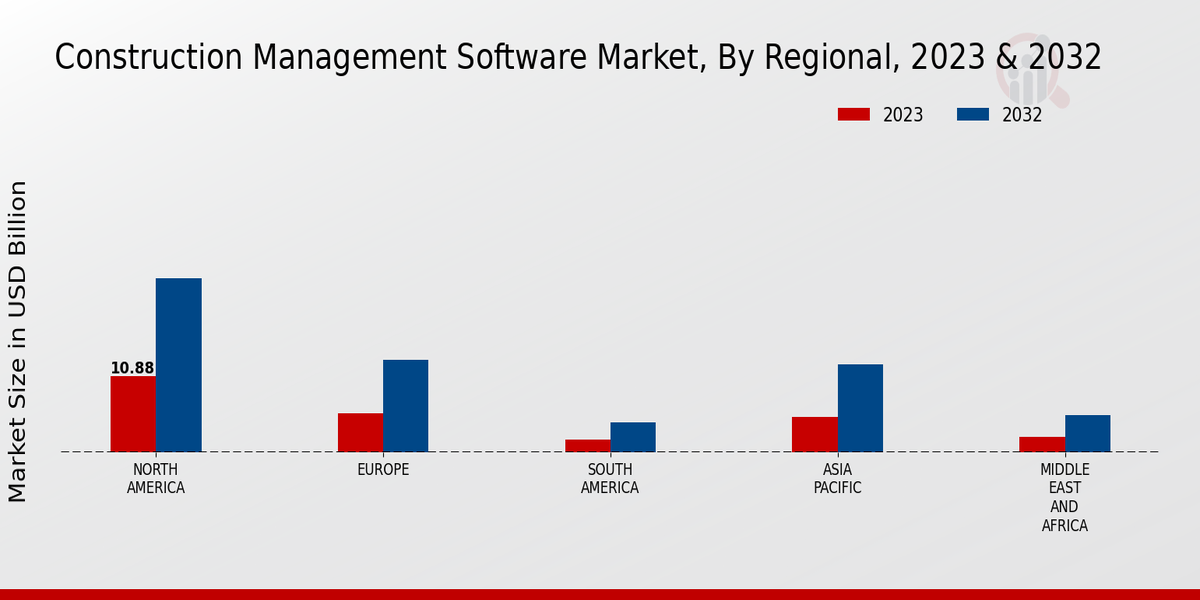Construction Management Software Market Overview
Construction Management Software Market is projected to grow from USD 29.26 Billion in 2025 to USD 67.39 Billion by 2034, exhibiting a compound annual growth rate (CAGR) of 9.71% during the forecast period (2025 - 2034).
Additionally, the market size for Construction Management Software Market was valued at USD 26.67 billion in 2024.
Key Construction Management Software Market Trends Highlighted
Several characteristics of the construction management software market include external and internal factors affecting the technology development such as growing customer expectations concerning software development time and expected use of the product, enhancing difficulty of construction works, and growing introduction of new technologies in the field. Potential for growth opportunities also includes the integration of artificial intelligence and the Internet of Things into construction management software. Also, stimulation for adoption comes from mobile technology and cloud computing.
Currently, there is a trend in the construction management software market where more and more integrated solutions designed to perform several functions are being implemented. Tools for grouping activities of participants in projects and those related to real-time data are on the rise. There is also an increasing trend towards the application of drones and sensor systems in data collection for projects and overseeing the progress. There is also demand for software that allows construction in line with the concept of sustainability because of the popularity of green buildings. The situation will not change in the market even in the future as the growth is expected to rise not less due to rise in areas of technology and the needs of construction as an industry.
Figure 1: Construction Management Software Market Size, 2025-2034 (USD Billion)

Source: Primary Research, Secondary Research, MRFR Database and Analyst Review
Construction Management Software Market Drivers
Increasing Adoption of Digital Technologies in Construction
The construction industry has traditionally been slow to adopt new technologies, but the increasing availability of affordable and easy-to-use construction management software is changing this trend. Construction companies are increasingly realizing the benefits of using software to manage their projects, including improved efficiency, productivity, and collaboration. This trend is expected to continue in the coming years, as more and more construction companies are adopting digital technologies to gain a competitive advantage. There are several factors driving the adoption of construction management software. One factor is the increasing complexity of construction projects. Construction projects are becoming larger and more complex, and this is making it more difficult for construction companies to manage them effectively using traditional methods. Construction management software can help construction companies to manage complex projects by providing them with a centralized platform for managing all aspects of the project, including planning, scheduling, budgeting, and communication. Another factor driving the adoption of construction management software is the increasing demand for transparency and accountability in the construction industry.
Owners and other stakeholders are increasingly demanding transparency and accountability from construction companies, and construction management software can help construction companies to meet these demands by providing them with a centralized platform for managing and tracking all aspects of the project. The increasing adoption of digital technologies in construction is creating a number of opportunities for construction management software providers. Construction management software providers can capitalize on this opportunity by developing and marketing software that is easy to use, affordable, and tailored to the specific needs of the construction industry.
Growing Demand for Sustainable Construction Practices
The growing demand for sustainable construction practices is another factor driving the growth of the Construction Management Software Market Industry. Construction companies are increasingly being asked to build sustainable buildings that are energy-efficient, environmentally friendly, and durable. Construction management software can help construction companies to meet these demands by providing them with tools to design, construct, and operate sustainable buildings. There are several factors driving the demand for sustainable construction practices. One factor is the increasing awareness of the environmental impact of construction. Construction activities can have a significant impact on the environment, including air pollution, water pollution, and deforestation. Sustainable construction practices can help to reduce the environmental impact of construction by using sustainable materials and construction methods.
Government Regulations and Incentives
Government regulations and incentives are also driving the growth of the Construction Management Software Market Industry. Governments around the world are increasingly implementing regulations and incentives to promote the adoption of sustainable construction practices. These regulations and incentives can include building codes, energy efficiency standards, and tax breaks for sustainable construction projects. Government regulations and incentives are creating a number of opportunities for construction management software providers. Construction management software providers can capitalize on this opportunity by developing and marketing software that helps construction companies to comply with government regulations and incentives.
Construction Management Software Market Segment Insights
Construction Management Software Market Deployment Model Insights
The Construction Management Software Market is segmented by deployment model into cloud and on-premises. The cloud segment is expected to grow at a faster rate than the on-premises segment during the forecast period. This growth is attributed to the increasing adoption of cloud-based solutions by construction companies as they offer several advantages such as scalability, flexibility, and cost-effectiveness. The cloud deployment model eliminates the need for construction companies to invest in and maintain their own IT infrastructure, which can be a significant cost saving. Additionally, cloud-based solutions can be accessed from anywhere with an internet connection, which improves collaboration and efficiency. The on-premises deployment model, on the other hand, requires construction companies to install and maintain their own software and hardware, which can be expensive and time-consuming. However, the on-premises deployment model offers some advantages, such as greater security and control over data. In 2023, the cloud deployment model accounted for a significant share of the Construction Management Software Market revenue. This share is expected to increase over the forecast period as more construction companies adopt cloud-based solutions.
The growth of the cloud segment is being driven by several factors, including the increasing availability of high-speed internet, the declining cost of cloud computing, and the growing popularity of software as a service (SaaS) solutions. The on-premises deployment model is expected to continue to account for a significant share of the Construction Management Software Market revenue over the forecast period. However, the growth of this segment is expected to be slower than the growth of the cloud segment. The on-premises deployment model is still preferred by some construction companies due to security and control concerns. Overall, the Construction Management Software Market is expected to experience significant growth over the forecast period. The growth of the market is being driven by the increasing adoption of construction management software solutions by construction companies. The cloud deployment model is expected to be the dominant deployment model over the forecast period due to its several advantages.

Source: Primary Research, Secondary Research, MRFR Database and Analyst Review
Construction Management Software Market Application Insights
The Application segment of the Construction Management Software Market is expected to witness significant growth in the coming years. Project Planning and Scheduling is a key application, with a market size of USD 4.23 billion in 2023 and projected to reach USD 8.12 billion by 2032, exhibiting a CAGR of 8.2%. This growth is attributed to the increasing need for efficient project planning and scheduling to optimize resource allocation and timelines. Cost Management is another major application, valued at USD 3.56 billion in 2023 and anticipated to reach USD 7.03 billion by 2032, growing at a CAGR of 8.3%. The rising demand for cost-effective construction practices is driving the adoption of cost management software. Document Management is also gaining traction, with a market size of USD 2.98 billion in 2023 and a projected value of USD 5.85 billion by 2032, growing at a CAGR of 8.4%.
The need for centralized and secure document management systems is fueling this growth. Resource Management is another important application, with a market size of USD 2.45 billion in 2023 and a projected value of USD 4.89 billion by 2032, growing at a CAGR of 8.5%. The increasing demand for efficient resource allocation and utilization is driving the adoption of resource management software. Quality Management is also witnessing significant growth, with a market size of USD 2.17 billion in 2023 and a projected value of USD 4.32 billion by 2032, growing at a CAGR of 8.6%. The growing focus on quality control and assurance is driving the adoption of quality management software. The increasing adoption of cloud-based construction management software is further fueling the growth of the Construction Management Software Market.
Construction Management Software Market End User Insights
The Construction Management Software Market segmentation by End User includes General Contractors, Construction Managers, Architects, Engineers, and Subcontractors. In 2023, General Contractors held the largest market share of 32.4%. The increasing adoption of construction management software by general contractors to streamline project management processes and improve collaboration is driving the growth of this segment. The Construction Managers segment is expected to witness significant growth during the forecast period due to the rising demand for professional construction management services. Architects and Engineers are also increasingly adopting construction management software to enhance design coordination, project planning, and documentation. Subcontractors are leveraging construction management software to improve communication, manage workflow, and track project progress. The Construction Management Software Market is expected to reach USD 26.42 billion in 2024, exhibiting a CAGR of 10.2% during the forecast period (2024-2032).
Construction Management Software Market Regional Insights
The Construction Management Software Market is segmented into North America, Europe, APAC, South America, and MEA. North America held the largest market share in 2023 and is expected to continue its dominance during the forecast period. The region's growth is attributed to the increasing adoption of construction management software by construction companies and the rising demand for efficient project management solutions. Europe is the second-largest market for construction management software, followed by APAC. The APAC region is expected to witness significant growth in the coming years due to the increasing construction activities in emerging economies such as China and India. South America and MEA are expected to have a steady growth rate during the forecast period. The increasing adoption of construction management software in these regions is driven by the need for improved project management and collaboration.

Source: Primary Research, Secondary Research, MRFR Database and Analyst Review
Construction Management Software Market Key Players And Competitive Insights
Major players in Construction Management Software Market industry are continuously investing in research and development to provide innovative solutions that meet the evolving needs of the construction sector. Leading Construction Management Software Market players are focusing on developing software with advanced features such as real-time data analytics, collaboration tools, and mobile capabilities. This intense competition is driving the Construction Management Software Market development and providing customers with a wide range of options to choose from. The Construction Management Software Market Competitive Landscape is expected to remain dynamic, with new entrants and established players constantly vying for market share. A leading player in the Construction Management Software Market is Oracle, which offers a comprehensive suite of construction management solutions under the Oracle Aconex brand. Oracle Aconex provides cloud-based and on-premises solutions for project management, collaboration, document management, and quality control.
The company has a strong presence and serves a wide range of construction companies, including contractors, owners, and engineers. Oracle Aconex is known for its user-friendly interface, robust features, and strong support network. A notable competitor in the Construction Management Software Market is Autodesk, which offers a range of construction management solutions under the Autodesk Construction Cloud brand. Autodesk Construction Cloud includes solutions for project management, collaboration, design coordination, and field management. The company has a strong focus on innovation and has been investing heavily in developing new technologies, such as artificial intelligence and machine learning. Autodesk Construction Cloud is widely used by construction companies of all sizes, from small contractors to large enterprises.
Key Companies in the Construction Management Software Market Include:
Construction Management Software Market Industry Developments
The construction management software market is projected to grow from USD 22.17 billion in 2023 to USD 51.01 billion by 2032, exhibiting a CAGR of 9.71% during the forecast period. The key factors driving the market growth include the rising adoption of digital technologies in the construction industry, increasing demand for efficient project management solutions, and growing awareness of the benefits of construction management software. Recent news developments and current affairs in the market include: Autodesk acquires Procore: In 2023, Autodesk, a leading provider of design and engineering software, acquired Procore, a leading provider of construction management software. This acquisition is expected to strengthen Autodesk's position in the construction industry and provide customers with a more comprehensive suite of solutions. Trimble launches a new construction management platform: In 2023, Trimble, a leading provider of construction technology solutions, launched Trimble Connect, a new cloud-based construction management platform. Trimble Connect provides a centralized platform for project management, collaboration, and data sharing, helping construction teams to improve efficiency and productivity. Bentley Systems releases new version of ProjectWise: In 2023, Bentley Systems, a leading provider of infrastructure engineering software, released a new version of ProjectWise, its construction management software. The new version includes enhanced features for project collaboration, document management, and risk management.
Construction Management Software Market Segmentation Insights
-
Construction Management Software Market Deployment Model Outlook
-
Cloud
-
Construction Management Software Market Application Outlook
-
Project Planning and Scheduling
-
Construction Management Software Market End User Outlook
-
General Contractors
-
Construction Management Software Market Regional Outlook
-
North America
| Report Attribute/Metric |
Details |
|
Market Size 2024
|
26.67 (USD Billion)
|
|
Market Size 2025
|
29.26 (USD Billion)
|
|
Market Size 2034
|
67.39 (USD Billion)
|
|
Compound Annual Growth Rate (CAGR)
|
9.71% (2025 - 2034)
|
|
Report Coverage
|
Revenue Forecast, Competitive Landscape, Growth Factors, and Trends
|
|
Base Year
|
2024
|
|
Market Forecast Period
|
2025 - 2034
|
|
Historical Data
|
2019 - 2023
|
|
Market Forecast Units
|
USD Billion
|
| Key Companies Profiled |
eBuilder, Trimble, GRAPHISOFT, Jonas Premier, Procore, Nemetschek, Bluebeam, CMiC, Oracle, Autodesk, StructionSite, JBKnowledge, ProEst, Bentley Systems, Sage |
| Segments Covered |
Deployment Model, Application, End User, Regional |
| Key Market Opportunities |
Cloud based solutions AI integration Mobile accessibility Predictive analytics Realtime collaboration |
| Key Market Dynamics |
Growing adoption of cloudbased solutions, Increasing demand for project visibility and control, Rise in urbanization and infrastructure projects, Integration of BIM and IoT technologies, Focus on sustainability and energy efficiency |
| Countries Covered |
North America, Europe, APAC, South America, MEA |
Frequently Asked Questions (FAQ) :
The Construction Management Software Market was valued at USD 29.26 billion in 2025 and is expected to reach USD 67.39 billion by 2034, exhibiting a CAGR of 9.71% during the forecast period.
North America and Europe are the dominant regions in the Construction Management Software Market, followed by Asia-Pacific and the Rest of the World.
Construction Management Software finds application in various stages of construction projects, including planning, scheduling, cost control, project management, and collaboration.
Key players operating in the market include Oracle, SAP, Trimble, Autodesk, and Bentley Systems, among others.
The market growth is driven by factors such as increasing adoption of digital technologies in construction, rising demand for efficient project management solutions, and growing infrastructure investments.
Challenges include data security concerns, lack of skilled professionals, and integration issues with existing systems.
The market is expected to witness significant growth in the coming years, driven by increasing government initiatives for infrastructure development and adoption of advanced technologies.
Key strategies include product innovation, partnerships, acquisitions, and expansion into new markets.
Emerging technologies such as artificial intelligence, machine learning, and blockchain are transforming the market by enhancing efficiency and productivity.
Sustainability is becoming an important factor, with vendors offering solutions that promote green building practices and reduce environmental impact.

















